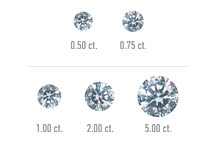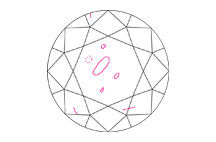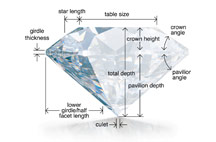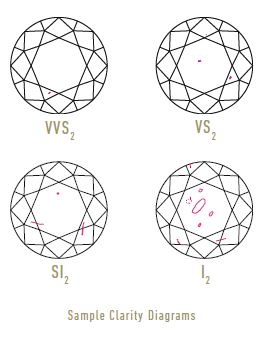Diamond Education
There is More to Diamonds Than Just Size…
Beauty is in the eye of the beholder. Some buyers prefer a larger diamond, while some are willing to sacrifice size for a better quality. Most JF Jones Brides opt for something in the middle. A nice combination of size and quality makes our most popular quality:
Color: F/G/H
Clarity: VS-2, SI-1 and SI-2
Cut: Very Good-Excellent
Brittany only buys the BEST diamonds. We are literally putting our families name on them.
Set up an appointment with our diamond buyer, Brittany, GIA Diamonds Graduate and Graduate Gemologist to see what quality you prefer. Many couples come in together for this and choose a setting.
The 4 C’s
The 4 C’s of Diamond Quality

Carat
Diamonds are weighed in carats. The higher the carat, the larger the diamond. The larger the diamond, the more rare it is.

Color
Diamonds are graded on the saturation of their color, or lack there of. The less color, the higher the grade and more rare.

Clarity
Clarity grades assess the number, size, relief and position of inclusions (inside) and blemishes (On the surface) of a diamond.

Cut
Cut (proportions, symmetry and polish) is a measure of how a diamond’s facets interact with light.
GIA Scales
Color
Most people think of gem quality diamonds as colorless, but did you know that diamonds come in every color of the rainbow? The most popular diamonds are in the colorless to near colorless range. Color grades are determined by
comparing each diamond to a master set. Each letter grade represents a range of color and is a measure of how noticeable a color is. Color is graded upside down the the pavilion (point) of a diamond. Many stones may “face up” better right side up. When setting in white gold or platinum we recommend a minimum of a J color.
Fluorescence Some diamonds can emit a visible light when exposed to ultraviolet radiation, but fluorescence is not a factor in determining color or clarity grades. However, a description of its strength and color is provided on GIA Reports as an additional identifying characteristic.

Clarity
Because diamonds form under tremendous heat and pressure, it is extremely rare to find a diamond that lacks any internal and external characteristics. These characteristics are a by-product of its formation and help gemologists separate natural diamonds from synthetics. The quantity, size, relief and type determine the clarity grade.
There are many types of clarity characteristics ranging from included carbon crystals (black spots,) feathers (white feather looking cracks) to clouds (multiple small pin point inclusions that give a cloudy appearance.) Be aware of surface reaching inclusions that can threaten the durability of the stone. A higher clarity diamond should sparkle more than a lower graded stone if they are both the same cut. But a better cut grade could improve the look of a lower clarity graded stone.
Cut
A polished diamond’s beauty lies in its complex relationship with light. The magnificent display you see is made up of three attributes:
Brightness is the combination of all white light reflecting from the surface and interior of a diamond.
Fire describes the “flares” of color emitted from a diamond.
Scintillation describes the pattern of light and dark areas and the sparkle you see when the diamond, the light, or the observer moves.
A diamond’s proportions affect its light performance, which in turn affects its beauty and overall appeal. Diamonds with fine proportions, symmetry, and polish optimize their interaction with light, and have increased brightness, fire, and scintillation.
Diamond cut can help to improve the appearance of a lower color or clarity stone. A poor cut can also make a great clarity graded stone appear dull. Most diamond cutters cut the diamond in a way to save weight, sometimes creating a deep stone that “faces up” small, or a shallow stone that “faces up” large, but lacks sparkle.
Brightness, Fire and Scintillation can not be seen on a computer screen, or on a lab report. They must be experienced!

Carat
Diamonds are weighed in Carats, like humans are weighed in pounds. Prices increase exponentially with size. Meaning a 1 carat diamond will not simply be double the price of a 1/2 carat diamond. We have diamonds in every size for you to try on. And if we don’t have exactly what you are looking for, we will get it!
Shape also plays a part in the way a diamond “faces up.” Different shapes carry their weight in different areas, some shapes naturally appear larger. A Marquise or oval for instance are relatively shallow cut shapes and face up larger than the standard round. Princess and cushion however tend to be deeper and face up smaller than the standard round.
We offer a lifetime trade up program on all of our natural diamonds so that you can upgrade later.
The Fifth C “SEE”
You have to SEE a diamond to experience it’s beauty. Not all diamonds look good on paper, and not all G VS-1’s are pretty. Just like trying to judge a woman’s beauty based on the stats of her drivers license. Just because she is 5′ 10″ blonde hair and 21 years old, does not ensure she will be pretty! Make sure you see a diamond before you buy it. We have over 95 years of experience buying beautiful diamonds and deep relationships with our vendors to give you the best diamond at the best price. That website online will not be there for you when you need your ring cleaned, a rush prong adjustment or help matching it to a wedding band. Support a local third generation woman owned business. We support our local community by donating to charities and providing jobs.


